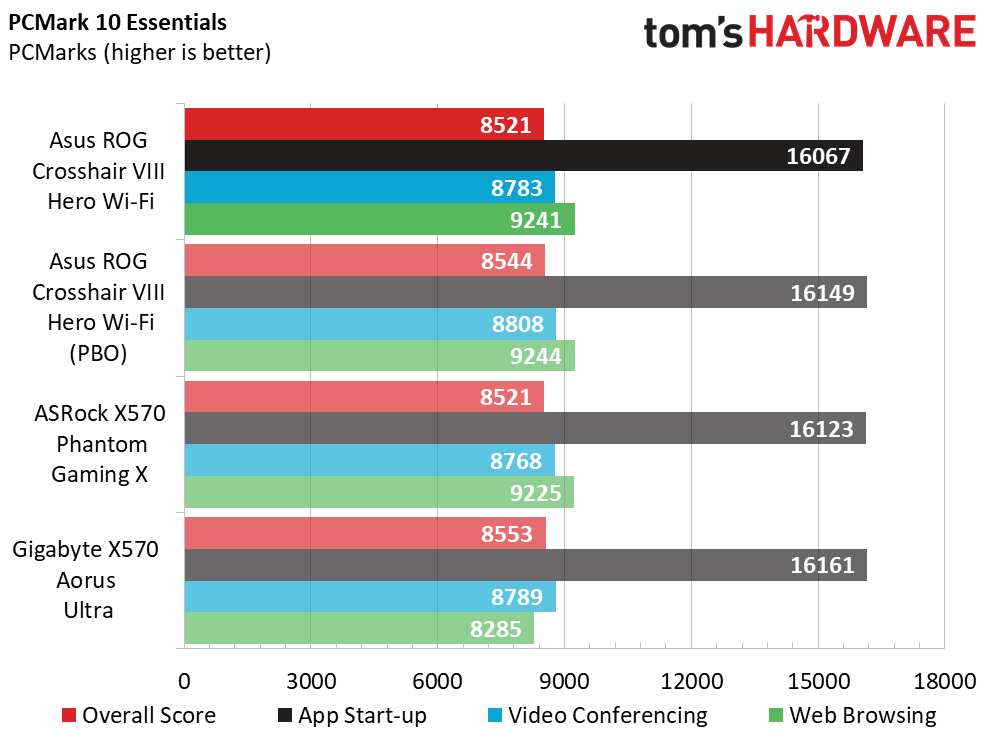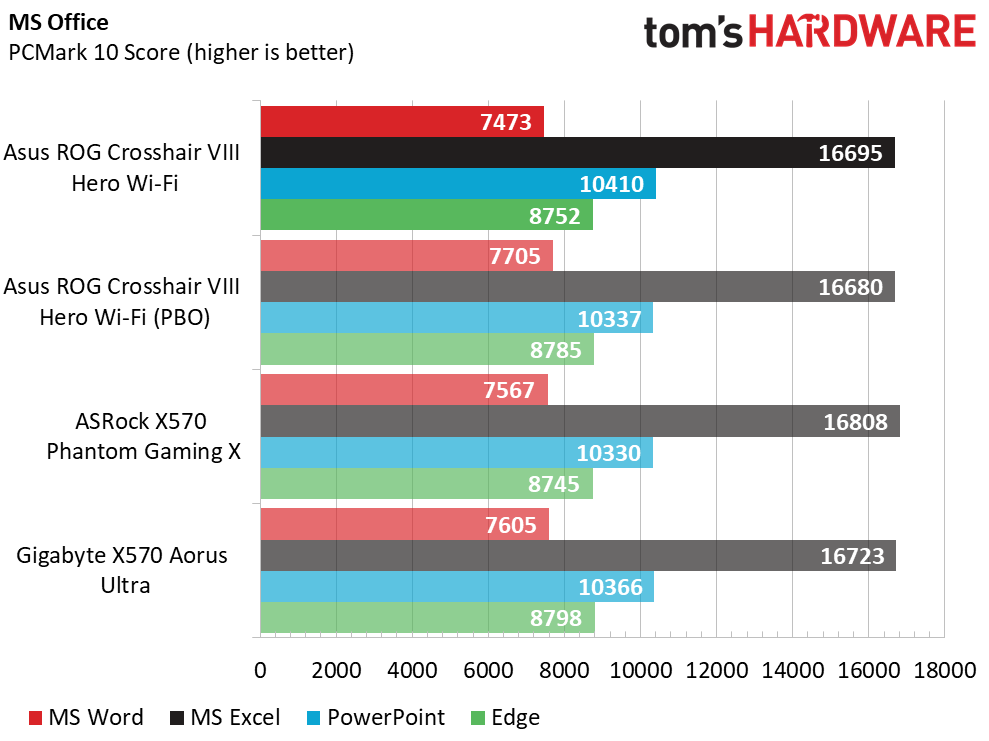Asus X570 ROG Crosshair VIII Hero Wi-Fi Review: Mid-Range Menagerie
Why you can trust Tom's Hardware
Benchmark and Final Analysis
All standard benchmarks and power tests are performed using the CPU’s stock frequencies (including stock AMD Turbo), with all of its power-saving features enabled. Optimized defaults are set in the BIOS and the memory set. The memory is manually set up to run at DDR4 3200 MHz (base spec for Zen 2) @ 16-18-18-38 primary timings.
Synthetic Benchmarks
Synthetics are a great tool to figure out if a board is running out of spec, as identical settings should produce extremely similar performance results. Advanced memory timings are the one place where motherboard makers can still optimize for either stability or performance though, and those settings can impact some testing.







In our synthetic set of tests, the Asus ROG Crosshair VIII Hero Wi-Fi results proved to be in line with the other X570 motherboards tested. All results were within general run variance difference with no anomalous data points. When enabling PBO, we saw a slight improvement across the board, around 1%, which wasn’t much, but is seemingly typical when simply enabled and not tweaked as all the other X570 boards we have reviewed came up with similar results. To really get the most out of these CPUs when using PBO, I suggest you tweak the limits they set forth.
3D Games


Game results continue to show a very tight set of data points without any appreciable differences. Nothing to worry about here for the Crosshair VIII Hero Wi-Fi.
Timed Applications


Our timed applications also show little difference between the boards. In this case, the Asus is a bit slower in Handbrake, but otherwise is just as fast as the other boards. 7Zip results were all fairly even.
Overall Performance
Overall, the Crosshair VIII Hero Wi-Fi performed well across our testing suite. It was only in the timed application benchmarks where it showed a slight difference. Users would be hard-pressed to notice such a small difference, but it is measurable and outside of typical run variance. This is a result of how the UEFI manages boost through testing.
Power & Relative Energy Efficiency


For power use, our Asus used a bit more power than the Gigabyte board, with a load rating in Prime 95 Small FFT coming in at 164W (versus 148W for the Aorus Ultra). The Phantom Gaming X used the most power under load, hitting 218W at stock settings. When enabling PBO, power use jumped to 219W peak, yielding 55W more use with little to show for it performance-wise. The Hero showed a 9.6% efficiency rating at stock. While not the most efficient (the Gigabyte X570 Aorus Ultra takes that crown) in this group, it is in the ballpark at stock.
Get Tom's Hardware's best news and in-depth reviews, straight to your inbox.
Overclocking
Overclocking on the Crosshair VIII Hero Wi-Fi yielded 4.224 GHz overclock with 1.32V on the core, which is right in the ballpark of other boards. The VRM’s handled the overclocking with aplomb, managing to be warm to the touch during testing but not hot. The heat pipe-connected VRM heatsinks do their job.
We successfully loaded up our GSKill Trident Z Neo 4x8GB DDR4 3600 16-16-16-36 sticks without issue here as well. The motherboard natively set the 1:1 ratio automatically, so we had no issues there.
This is the first board we’ve reviewed that had voltage read points, so we decided to see how accurate CPUz was with this board. If we set a voltage of 1.33V in the UEFI, this yielded 1.328V in CPUz in windows. Our multi-meter showed 1.33V (rounded up). In the end, it was very accurate. With the LLC set to auto, we saw no appreciable vdroop. Asus’ unique VRM implementation didn’t have any issues with our mid-range 3700X.
IMG (017 - 425ghz crosshr)
Overall, the board clocked well and is able to reach the same speed as the other boards tested without breaking a sweat. The board should be able to handle even the mighty 3950X when it arrives -- now supposedly in November.
A quick side note: using the latest BIOS (which updates to AGESA 1.0.0.3 ABBA), our 3700X also reached the max boost clocks. Prior to this update, not one board was able to see this CPU hit the rated single-core boost clock. Hopefully AMD has that behind it now, although as we’ve reported elsewhere, our testing shows the boosts don’t always land on the right (active) core.
Final Thoughts
The Asus ROG Crosshair VIII Hero Wi-Fi ($380), handled our testing without any major issue. Overclocking was limited by temperature, not by the board, and it has loads of features too. If you need lots of USB ports on the back, it’s worth considering for the 12 that live there alone. The Crosshair VIII also provides eight SATA ports along with two M.2 slots, the latter both including heatsinks on them. Another notable feature on this board is the 2.5G Realtek LAN port, which provides users with faster than Gigabit NIC. You’ll of course need a compatible router and / or switch th take advantage of that speed, though.
About the only complaint or concern I have with the board is the placement of the chipset fan, which will essentially be closed off when using any dual-slot GPU, as well as having its source of cool air choked off. We didn’t have any issues during testing, but we also are not using a PCIe 4.0 GPU nor an M.2 module either. The good news is that the fan wasn’t audible during testing. This tells me the concern is probably minor.
Overall, the Asus ROG Crosshair VIII Hero Wi-Fi is a very capable board and a good choice for a mid-range to high-end X570 build. It has more USB ports than the other boards in the roundup (12 compared to 8 or less), a 2.5G ethernet and eight SATA ports. Only ASRock Phantom Gaming X matches the latter specs. Between its sophisticated appearance, robust power delivery, and large feature set, this Asus model should be on the shortlist if shopping in the $350-$400 price range.
Image Credits: Tom's Hardware
MORE: Best Motherboards
MORE: How To Choose A Motherboard
MORE: All Motherboard Content

Joe Shields is a staff writer at Tom’s Hardware. He reviews motherboards and PC components.
-
slash3 One correction for the first page - the bottom PCI-E x16 (physical) slot is an x4 (effective) from the PCH, not x8.Reply
